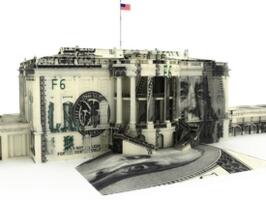62% Understand That Spending Cuts Really Means Slowing Pace of Spending
Congress and presidents have been playing the “spending cuts” game for years, but most voters know what they’re really talking about.
Sixty-two percent (62%) of Likely U.S. Voters understand that when Congress mentions future spending cuts, they’re really saying the growth in government spending will be less than planned. A new Rasmussen Reports national telephone survey finds that just 19% think it means spending next year will be lower than this year’s. Twenty percent (20%) aren’t sure which is right. (To see survey question wording, click here.)
Interestingly, those who are pushing hardest for government spending cuts are the ones who are most aware of what those cuts really mean. Two-out-of-three Republicans and voters not affiliated with either party – 67% - recognize that congressional promises of spending cuts mean the growth of spending will be less than planned, but just 51% of Democrats share that awareness.
Voters have also grown aware of the fact that most federal spending goes to just three program areas—National Security, Social Security, and Medicare. At the beginning of 2010, just 32% believed that to be true. Now, just over half are aware. But distrust of Congress leads 68% to say any proposed changes in either Social Security or Medicare should be submitted to the American people for a vote before they become law.
The federal government has been using a process known as Current Services Budgeting since the 1970s to report spending changes. That means the “baseline” for spending is assumed to include all the spending growth that is already built into the federal budget. Much of that growth comes from what the Congressional offices call “uncontrollable spending,” which includes entitlement programs and accounts for the vast majority of all federal spending.
To see the impact of Current Services Budgeting, assume that government is projected to grow by 10% from one-year to the next. If that spending grows by just 5%, Congressional scorekeeping would consider that to be a 5% cut. However, in the real world, an increase in spending by 5% is an increase in spending no matter how you spin it. To be precise, the official numbers would consider that to be a reduction in “current services” but politicians have long since lost that distinction.
The budget submitted by President Barack Obama earlier this year projected spending for the current fiscal year of $3.8 trillion. That’s up from $2.7 trillion four years ago. Looking ahead to four years from now, the President projected spending to be $4.2 trillion.
Fifty-six percent (56%) of voters favor a law that limits the growth of U.S. government spending each year to how much the population has grown plus inflation. Government spending has grown faster than that every year but one since 1965.
(Want a free daily e-mail update? If it's in the news, it's in our polls). Rasmussen Reports updates are also available on Twitter or Facebook.
The survey of 1,000 Likely Voters was conducted on August 3-4, 2011 by Rasmussen Reports. The margin of sampling error is +/- 3 percentage points with a 95% level of confidence. Field work for all Rasmussen Reports surveys is conducted by Pulse Opinion Research, LLC. See methodology.
Rasmussen Reports is a media company specializing in the collection, publication and distribution of public opinion information.
We conduct public opinion polls on a variety of topics to inform our audience on events in the news and other topics of interest. To ensure editorial control and independence, we pay for the polls ourselves and generate revenue through the sale of subscriptions, sponsorships, and advertising. Nightly polling on politics, business and lifestyle topics provides the content to update the Rasmussen Reports web site many times each day. If it's in the news, it's in our polls. Additionally, the data drives a daily update newsletter and various media outlets across the country.
Some information, including the Rasmussen Reports daily Presidential Tracking Poll and commentaries are available for free to the general public. Subscriptions are available for $4.95 a month or 34.95 a year that provide subscribers with exclusive access to more than 20 stories per week on upcoming elections, consumer confidence, and issues that affect us all. For those who are really into the numbers, Platinum Members can review demographic crosstabs and a full history of our data.
To learn more about our methodology, click here.


